Submitted:
30 October 2023
Posted:
31 October 2023
You are already at the latest version
Abstract

Keywords:
1. Introduction
- Elucidate the design and implementation of the RELAD-ANN and LSIPF models, specifically tailored to address the intricacies inherent in SI forecasting;
- Incorporate the prowess of SVR and Light GBM regressors to ascertain and elevate prediction accuracy; and
- Empirically validate the proposed models against robust statistical benchmarks, affirming their viability for broader applications.
2. Materials and Methods
2.1. Selection of Location and Parameters
2.2. Data Pre-Processing
2.3. Model Development for Parametric Forecasting
2.3.1. ANN model with ReLU activation and ADAM optimizer (RELAD-ANN)
2.3.2. Linear SVM with Individual Parameter Features (LSIPF)
2.4. Analysing Meteorological Parameter Influence on Solar Irradiance using Advanced Regression Techniques
2.4.1. Support Vector Regression (SVR)
2.4.2. Lightweight Gradient Boosting Machines (Light GBM)
- n is the number of data points;
- yi is the true value for the i-th data point; and
- ŷi is the predicted value for the i-th data point.
2.5. Model Validation
3. Results and Discussion
3.1. Parametric Forecasting
3.2. Meteorological Parameter Influence on Solar Irradiance
4. Conclusions
- The RELAD-ANN model, leveraging its artificial neural network structure, consistently demonstrates superior forecasting capabilities for SI although being influenced by meteorological parameters. Its strength is particularly pronounced in accurately predicting specific humidity and air temperature, though it exhibits some challenges in capturing rare high-speed wind occurrences.
- The LSIPF model, while exhibiting commendable precision for parameters like wind speed and air temperature, manifests evident limitations, particularly in predicting specific humidity. Its comparative inferiority in SI prediction further emphasizes the overarching proficiency of the RELAD-ANN model.
- Light GBM, when contrasted with the SVR model, reveals a more holistic and adept approach in evaluating the influences of environmental parameters on SI. Its strength in addressing the intricate interplay of these parameters, especially specific humidity, positions it as an indispensable tool for such predictive tasks.
Author Contributions
Funding
Data Availability Statement
Conflicts of Interest
References
- Guan, Y.; Lu, H.; Jiang, Y.; Tian, P.; Qiu, L.; Pellikka, P.; Heiskanen, J. Changes in Global Climate Heterogeneity under the 21st Century Global Warming. Ecol Indic 2021, 130, 108075. [Google Scholar] [CrossRef]
- Edenhofer, O.; Pichs-Madruga, R.; Sokona Mali, Y.; Kadner, S.; Minx, J.C.; Brunner, S.; Agrawala, S.; Baiocchi, G.U.; Alexeyevich Bashmakov, I.; Blanco, G.; et al. TS Technical Summary Coordinating Lead Authors: Lead Authors.
- By Daniel Sperling, J.S.C. Driving Climate Change: Cutting Carbon from Transportation; Elsevier, 2010.
- Janke, J.R. Multicriteria GIS Modeling of Wind and Solar Farms in Colorado. Renew Energy 2010, 35, 2228–2234. [Google Scholar] [CrossRef]
- Dincer, I. Renewable Energy and Sustainable Development: A Crucial Review. Renewable & sustainable energy reviews 2000, 4, 157–175. [Google Scholar] [CrossRef]
- Sohani, A.; Shahverdian, M.H.; Sayyaadi, H.; Hoseinzadeh, S.; Memon, S.; Piras, G.; Garcia, D.A. Energy and Exergy Analyses on Seasonal Comparative Evaluation of Water Flow Cooling for Improving the Performance of Monocrystalline PV Module in Hot-Arid Climate. Sustainability (Switzerland) 2021, 13. [Google Scholar] [CrossRef]
- Sahebi, H.K.; Hoseinzadeh, S.; Ghadamian, H.; Ghasemi, M.H.; Esmaeilion, F.; Garcia, D.A. Techno-Economic Analysis and New Design of a Photovoltaic Power Plant by a Direct Radiation Amplification System. Sustainability (Switzerland) 2021, 13. [Google Scholar] [CrossRef]
- Hoseinzadeh, S.; Ghasemi, M.H.; Heyns, S. Application of Hybrid Systems in Solution of Low Power Generation at Hot Seasons for Micro Hydro Systems. Renew Energy 2020, 160, 323–332. [Google Scholar] [CrossRef]
- Makkiabadi, M.; Hoseinzadeh, S.; Mohammadi, M.; Nowdeh, S.A.; Bayati, S.; Jafaraghaei, U.; Mirkiai, S.M.; Assad, M.E.H. Energy Feasibility of Hybrid PV/Wind Systems with Electricity Generation Assessment under Iran Environment. Applied Solar Energy (English translation of Geliotekhnika) 2020, 56, 517–525. [Google Scholar] [CrossRef]
- Hannan, M.A.; Al-Shetwi, A.Q.; Ker, P.J.; Begum, R.A.; Mansor, M.; Rahman, S.A.; Dong, Z.Y.; Tiong, S.K.; Mahlia, T.M.I.; Muttaqi, K.M. Impact of Renewable Energy Utilization and Artificial Intelligence in Achieving Sustainable Development Goals. Energy Reports 2021, 7, 5359–5373. [Google Scholar] [CrossRef]
- Rafique, M.M.; Rehman, S. National Energy Scenario of Pakistan – Current Status, Future Alternatives, and Institutional Infrastructure: An Overview. Renewable and Sustainable Energy Reviews 2017, 69, 156–167. [Google Scholar] [CrossRef]
- IEA Snapshot of Global PV Markets 2014. Www.Iea-Pvps.Org 2015, 1–16.
- Pikus, M.; Wąs, J. Using Deep Neural Network Methods for Forecasting Energy Productivity Based on Comparison of Simulation and DNN Results for Central Poland—Swietokrzyskie Voivodeship. Energies (Basel) 2023, 16, 6632. [Google Scholar] [CrossRef]
- Rafique, M.M.; Bahaidarah, H.M.S.; Anwar, M.K. Enabling Private Sector Investment in Off-Grid Electrification for Cleaner Production: Optimum Designing and Achievable Rate of Unit Electricity. J Clean Prod 2019, 206, 508–523. [Google Scholar] [CrossRef]
- Council, E.A. Integrated Energy Plan 2009-2022 Report of the Energy Expert Group. 2009.
- Sørensen, M.L.; Nystrup, P.; Bjerregård, M.B.; Møller, J.K.; Bacher, P.; Madsen, H. Recent Developments in Multivariate Wind and Solar Power Forecasting. Wiley Interdiscip Rev Energy Environ 2023, 12. [Google Scholar] [CrossRef]
- ARENA (2019) $9 Million Funding to Enhance Term Forecasting of Wind and Solar Farms”, Australian Renewable Energy Agency; 2018.
- Brancucci Martinez-Anido, C.; Botor, B.; Florita, A.R.; Draxl, C.; Lu, S.; Hamann, H.F.; Hodge, B.M. The Value of Day-Ahead Solar Power Forecasting Improvement. Solar Energy 2016, 129, 192–203. [Google Scholar] [CrossRef]
- Madeleine Cuff AI-Powered Weather Forecasts Are Improving Predictions for Smart Grids’ Energy Outputs.
- Newsom, G.; Brown, E.G. Improving Solar and Load Forecasts by Reducing Operational Uncertainty California Energy Commission Month Year; 2019.
- Office of Energy Efficiency & Renewable Energy EERE Success Story—Solar Forecasting Platform Helps Grid Operators Plan Energy Mix.
- Solar Energy Technologies Office Success Story—Novel Approach to Solar Forecasting Delivers Improved Reliability and Economic Savings for Texas Grid.
- Farooqui, S.Z. Prospects of Renewables Penetration in the Energy Mix of Pakistan. Renewable and Sustainable Energy Reviews 2014, 29, 693–700. [Google Scholar] [CrossRef]
- Government of pakistan, F.D. Pakistan Economic Survey 2021-22; 2022.
- Đukanović, M.; Kašćelan, L.; Vuković, S.; Martinović, I.; Ćalasan, M. A Machine Learning Approach for Time Series Forecasting with Application to Debt Risk of the Montenegrin Electricity Industry. Energy Reports 2023, 9, 362–369. [Google Scholar] [CrossRef]
- Irfan, M.; Zhao, Z.Y.; Mukeshimana, M.C.; Ahmad, M. Wind Energy Development in South Asia: Status, Potential and Policies. 2019 2nd International Conference on Computing, Mathematics and Engineering Technologies, iCoMET 2019 2019, 1–6. [CrossRef]
- International Energy Agency Available online: https://www.iea.org/regions/asia-pacific.
- Rafique, M.M.; Rehman, S. National Energy Scenario of Pakistan – Current Status, Future Alternatives, and Institutional Infrastructure: An Overview. Renewable and Sustainable Energy Reviews 2017, 69, 156–167. [Google Scholar] [CrossRef]
- Awan, U.; Knight, I. Domestic Sector Energy Demand and Prediction Models for Punjab Pakistan. Journal of Building Engineering 2020, 32, 101790. [Google Scholar] [CrossRef]
- Muhammad, F.; Waleed Raza, M.; Khan, S.; Khan, F. Different Solar Potential Co-Ordinates of Pakistan. Innovative Energy & Research 2017, 06, 1–8. [Google Scholar] [CrossRef]
- Farooq, M.; Shakoor, A. Severe Energy Crises and Solar Thermal Energy as a Viable Option for Pakistan. Journal of Renewable and Sustainable Energy 2013, 5. [Google Scholar] [CrossRef]
- Shabbir, N.; Usman, M.; Jawad, M.; Zafar, M.H.; Iqbal, M.N.; Kütt, L. Economic Analysis and Impact on National Grid by Domestic Photovoltaic System Installations in Pakistan. Renew Energy 2020, 153, 509–521. [Google Scholar] [CrossRef]
- Meenal, R.; Binu, D.; Ramya, K.C.; Michael, P.A.; Vinoth Kumar, K.; Rajasekaran, E.; Sangeetha, B. Weather Forecasting for Renewable Energy System: A Review. Archives of Computational Methods in Engineering 2022, 29, 2875–2891. [Google Scholar] [CrossRef]
- David, M.; Alonso-Montesinos, J.; Le Gal La Salle, J.; Lauret, P. Probabilistic Solar Forecasts as a Binary Event Using a Sky Camera. Energies (Basel) 2023, 16, 7125. [Google Scholar] [CrossRef]
- Rozon, F.; McGregor, C.; Owen, M. Long-Term Forecasting Framework for Renewable Energy Technologies’ Installed Capacity and Costs for 2050. Energies (Basel) 2023, 16. [Google Scholar] [CrossRef]
- Harrou, F.; Sun, Y.; Taghezouit, B.; Dairi, A. Artificial Intelligence Techniques for Solar Irradiance and PV Modeling and Forecasting. Energies (Basel) 2023, 16, 6731. [Google Scholar] [CrossRef]
- Vennila, C.; Titus, A.; Sudha, T.S.; Sreenivasulu, U.; Reddy, N.P.R.; Jamal, K.; Lakshmaiah, D.; Jagadeesh, P.; Belay, A. Forecasting Solar Energy Production Using Machine Learning. International Journal of Photoenergy 2022, 2022. [Google Scholar] [CrossRef]
- Gneiting, T.; Lerch, S.; Schulz, B. Probabilistic Solar Forecasting: Benchmarks, Post-Processing, Verification. Solar Energy 2023, 252, 72–80. [Google Scholar] [CrossRef]
- Haider, S.A.; Sajid, M.; Sajid, H.; Uddin, E.; Ayaz, Y. Deep Learning and Statistical Methods for Short- and Long-Term Solar Irradiance Forecasting for Islamabad. Renew Energy 2022, 198, 51–60. [Google Scholar] [CrossRef]
- Tawn, R.; Browell, J. A Review of Very Short-Term Wind and Solar Power Forecasting A R T I C L E I N F O. 2021. [CrossRef]
- Singla, P.; Duhan, M.; Saroha, S. A Comprehensive Review and Analysis of Solar Forecasting Techniques; 2022; Vol. 16; ISBN 1170802107227.
- Verma, M.; Ghritlahre, H.K.; Chandrakar, G. Wind Speed Prediction of Central Region of Chhattisgarh (India) Using Artificial Neural Network and Multiple Linear Regression Technique: A Comparative Study. Annals of Data Science 2023, 10, 851–873. [Google Scholar] [CrossRef]
- Rajasundrapandiyanleebanon, T.; Kumaresan, K.; Murugan, S.; Subathra, M.S.P.; Sivakumar, M. Solar Energy Forecasting Using Machine Learning and Deep Learning Techniques. Archives of Computational Methods in Engineering 2023, 30, 3059–3079. [Google Scholar] [CrossRef]
- Heng, S.Y.; Ridwan, W.M.; Kumar, P.; Ahmed, A.N.; Fai, C.M.; Birima, A.H.; El-Shafie, A. Artificial Neural Network Model with Different Backpropagation Algorithms and Meteorological Data for Solar Radiation Prediction. Sci Rep 2022, 12. [Google Scholar] [CrossRef]
- Geetha, A.; Santhakumar, J.; Sundaram, K.M.; Usha, S.; Thentral, T.M.T.; Boopathi, C.S.; Ramya, R.; Sathyamurthy, R. Prediction of Hourly Solar Radiation in Tamil Nadu Using ANN Model with Different Learning Algorithms. Energy Reports 2022, 8, 664–671. [Google Scholar] [CrossRef]
- Alirahmi, S.M.; Khoshnevisan, A.; Shirazi, P.; Ahmadi, P.; Kari, D. Soft Computing Based Optimization of a Novel Solar Heliostat Integrated Energy System Using Artificial Neural Networks. Sustainable Energy Technologies and Assessments 2022, 50. [Google Scholar] [CrossRef]
- Mohammad, A.; Mahjabeen, F. Revolutionizing Solar Energy: The Impact of Artificial Intelligence on Photovoltaic Systems. 2023, 2. 2. [CrossRef]
- Alassery, F.; Alzahrani, A.; Khan, A.I.; Irshad, K.; R. Kshirsagar, S. An Artificial Intelligence-Based Solar Radiation Prophesy Model for Green Energy Utilization in Energy Management System. Sustainable Energy Technologies and Assessments 2022, 52. [CrossRef]
- HALTON, C. Predictive Analytics: Definition, Model Types, and Uses Available online: https://www.investopedia.com/terms/p/predictive-analytics.asp#:~:text=The most common predictive models,deep learning methods and technologies.
- Manju, S.; Sandeep, M. Prediction and Performance Assessment of Global Solar Radiation in Indian Cities: A Comparison of Satellite and Surface Measured Data. J Clean Prod 2019, 230, 116–128. [Google Scholar] [CrossRef]
- Kumar, N.; Sinha, U.K.; Sharma, S.P.; Nayak, Y.K. Prediction of Daily Global Solar Radiation Using Neural Networks with Improved Gain Factors and RBF Networks. International Journal of Renewable Energy Research 2017, 7, 1235–1244. [Google Scholar] [CrossRef]
- Siva Krishna Rao K, D. V.; Premalatha, M.; Naveen, C. Models for Forecasting Monthly Mean Daily Global Solar Radiation from In-Situ Measurements: Application in Tropical Climate, India. Urban Clim 2018, 24, 921–939. [Google Scholar] [CrossRef]
- Ahmad, S.; Parvez, M.; Khan, T.A.; Khan, O. A Hybrid Approach Using AHP–TOPSIS Methods for Ranking of Soft Computing Techniques Based on Their Attributes for Prediction of Solar Radiation. Environmental Challenges 2022, 9, 100634. [Google Scholar] [CrossRef]
- Ağbulut, Ü.; Gürel, A.E.; Biçen, Y. Prediction of Daily Global Solar Radiation Using Different Machine Learning Algorithms: Evaluation and Comparison. Renewable and Sustainable Energy Reviews 2021, 135. [Google Scholar] [CrossRef]
- Yıldırım, H.B.; Çelik, Ö.; Teke, A.; Barutçu, B. Estimating Daily Global Solar Radiation with Graphical User Interface in Eastern Mediterranean Region of Turkey. Renewable and Sustainable Energy Reviews 2018, 82, 1528–1537. [Google Scholar] [CrossRef]
- Islam, S.; Roy, N.K. Renewables Integration into Power Systems through Intelligent Techniques: Implementation Procedures, Key Features, and Performance Evaluation. Energy Reports 2023, 9, 6063–6087. [Google Scholar] [CrossRef]
- Deo, R.C.; Wen, X.; Qi, F. A Wavelet-Coupled Support Vector Machine Model for Forecasting Global Incident Solar Radiation Using Limited Meteorological Dataset. Appl Energy 2016, 168, 568–593. [Google Scholar] [CrossRef]
- Li, R.; Wang, H.N.; He, H.; Cui, Y.M.; Du, Z. Le Support Vector Machine Combined with K-Nearest Neighbors for Solar Flare Forecasting. Chinese Journal of Astronomy and Astrophysics 2007, 7, 441–447. [Google Scholar] [CrossRef]
- Li, R.; Cui, Y.; He, H.; Wang, H. Application of Support Vector Machine Combined with K-Nearest Neighbors in Solar Flare and Solar Proton Events Forecasting. Advances in Space Research 2008, 42, 1469–1474. [Google Scholar] [CrossRef]
- Wang, F.; Zhen, Z.; Wang, B.; Mi, Z. Comparative Study on KNN and SVM Based Weather Classification Models for Day Ahead Short Term Solar PV Power Forecasting. Applied Sciences (Switzerland) 2017, 8. [Google Scholar] [CrossRef]
- Solargis Global Solar Atlas 2.0 GHI Map of Pakistan Utilizing Solargis Data Available online: https://globalsolaratlas.info/map?c=30.628459,68.983154,6&r=PAK.
- (CDPC), C.D.P.C.; Department, P.M. Climate Records Quetta Available online: http://www.pmd.gov.pk/cdpc/home.htm.
- Solargis Global Solar Atlas 2.0 Quetta 30.195768°,067.017245°.
- NASA Giovanni Available online: https://giovanni.gsfc.nasa.gov/giovanni/.
- Yoon, J.; Jordon, J.; Van Der Schaar, M. GAIN: Missing Data Imputation Using Generative Adversarial Nets; 2018.
- Andrews, J.; Gorell, S. Generating Missing Unconventional Oilfield Data Using a Generative Adversarial Imputation Network (GAIN).; American Association of Petroleum Geologists AAPG/Datapages, August 20 2020.
- Shahbazian, R.; Trubitsyna, I. DEGAIN: Generative-Adversarial-Network-Based Missing Data Imputation. Information (Switzerland) 2022, 13. [Google Scholar] [CrossRef]
- Zhang, Y.; Zhang, R.; Zhao, B. A Systematic Review of Generative Adversarial Imputation Network in Missing Data Imputation. Neural Comput Appl 2023, 35, 19685–19705. [Google Scholar] [CrossRef]
- Awan, S.E.; Bennamoun, M.; Sohel, F.; Sanfilippo, F.; Dwivedi, G. Imputation of Missing Data with Class Imbalance Using Conditional Generative Adversarial Networks. Neurocomputing 2021, 453, 164–171. [Google Scholar] [CrossRef]
- Friedjungová, M.; Vašata, D.; Balatsko, M.; Jiřina, M. Missing Features Reconstruction Using a Wasserstein Generative Adversarial Imputation Network. In Proceedings of the Lecture Notes in Computer Science (including subseries Lecture Notes in Artificial Intelligence and Lecture Notes in Bioinformatics); Springer Science and Business Media Deutschland GmbH, 2020; Vol. 12140 LNCS, pp. 225–239.
- (2015), P.C.T. Python: A Dynamic, Open Source Programming Language. Python Software Foundation.
- Gholizadeh, S. Top Popular Python Libraries in Research; 2022; Vol. 3;
- Stančin, I.; Jović, A. An Overview and Comparison of Free Python Libraries for Data Mining and Big Data Analysis.
- Voigtlaender, F. The Universal Approximation Theorem for Complex-Valued Neural Networks. Appl Comput Harmon Anal 2023, 64, 33–61. [Google Scholar] [CrossRef]
- Winkler, D.A.; Le, T.C. Performance of Deep and Shallow Neural Networks, the Universal Approximation Theorem, Activity Cliffs, and QSAR. Mol Inform 2017, 36. [Google Scholar] [CrossRef]
- Lu, Y.; Lu, J. A Universal Approximation Theorem of Deep Neural Networks for Expressing Probability Distributions.
- Dubey, S.R.; Singh, S.K.; Chaudhuri, B.B. Activation Functions in Deep Learning: A Comprehensive Survey and Benchmark. Neurocomputing 2022, 503, 92–108. [Google Scholar] [CrossRef]
- Tato, A.; Nkambou, R. Workshop Track-ICLR 2018 IMPROVING ADAM OPTIMIZER.
- Toh, S.C.; Lai, S.H.; Mirzaei, M.; Soo, E.Z.X.; Teo, F.Y. Sequential Data Processing for IMERG Satellite Rainfall Comparison and Improvement Using LSTM and ADAM Optimizer. Applied Sciences (Switzerland) 2023, 13. [Google Scholar] [CrossRef]
- Amose, J.; Manimegalai, P.; Narmatha, C.; Pradeep Raj, M.S. Amose, J.; Manimegalai, P.; Narmatha, C.; Pradeep Raj, M.S. Comparative Performance Analysis of Kernel Functions in Support Vector Machines in the Diagnosis of Pneumonia Using Lung Sounds. In Proceedings of the Proceedings of 2022 2nd International Conference on Computing and Information Technology, ICCIT 2022; Institute of Electrical and Electronics Engineers Inc., 2022; pp. 320–324.
- Karyawati, A.E.; Wijaya, K.D.Y.; Supriana, I.W.; Supriana, I.W. A COMPARISON OF DIFFERENT KERNEL FUNCTIONS OF SVM CLASSIFICATION METHOD FOR SPAM DETECTION. JITK (Jurnal Ilmu Pengetahuan dan Teknologi Komputer) 2023, 8, 91–97. [Google Scholar] [CrossRef]
- Munir, M.A.; Khattak, A.; Imran, K.; Ulasyar, A.; Khan, A. Solar PV Generation Forecast Model Based on the Most Effective Weather Parameters. 1st International Conference on Electrical, Communication and Computer Engineering, ICECCE 2019 2019, 24–25. [CrossRef]
- Wang, F.; Mi, Z.; Su, S.; Zhao, H. Short-Term Solar Irradiance Forecasting Model Based on Artificial Neural Network Using Statistical Feature Parameters. Energies (Basel) 2012, 5, 1355–1370. [Google Scholar] [CrossRef]
- Kashyap, Y.; Bansal, A.; Sao, A.K. Solar Radiation Forecasting with Multiple Parameters Neural Networks. Renewable and Sustainable Energy Reviews 2015, 49, 825–835. [Google Scholar] [CrossRef]
- Sayad, Dr.S. Support Vector Machine - Regression (SVR). Available online: http://www.saedsayad.com/support_vector_machine_reg.htm.
- Lu, Y.; Roychowdhury, V. Parallel Randomized Sampling for Support Vector Machine (SVM) and Support Vector Regression (SVR). Knowl Inf Syst 2008, 14, 233–247. [Google Scholar] [CrossRef]
- Kleynhans, T.; Montanaro, M.; Gerace, A.; Kanan, C. Predicting Top-of-Atmosphere Thermal Radiance Using MERRA-2 Atmospheric Data with Deep Learning. Remote Sens (Basel) 2017, 9, 1–16. [Google Scholar] [CrossRef]
- ©2022 Obviously AI, Inc. Obviously AI: Data Science without Code. Available online: https://app.obviously.ai/predict.
- Team, D.S. What Is Light GBM? Available online: https://datascience.eu/machine-learning/1-what-is-light-gbm/.
- Mandot, P. What Is LightGBM, How to Implement It? How to Fine Tune the Parameters? medium 2017.
- Gueymard, C.A. A Review of Validation Methodologies and Statistical Performance Indicators for Modeled Solar Radiation Data: Towards a Better Bankability of Solar Projects. Renewable and Sustainable Energy Reviews 2014, 39, 1024–1034. [Google Scholar] [CrossRef]
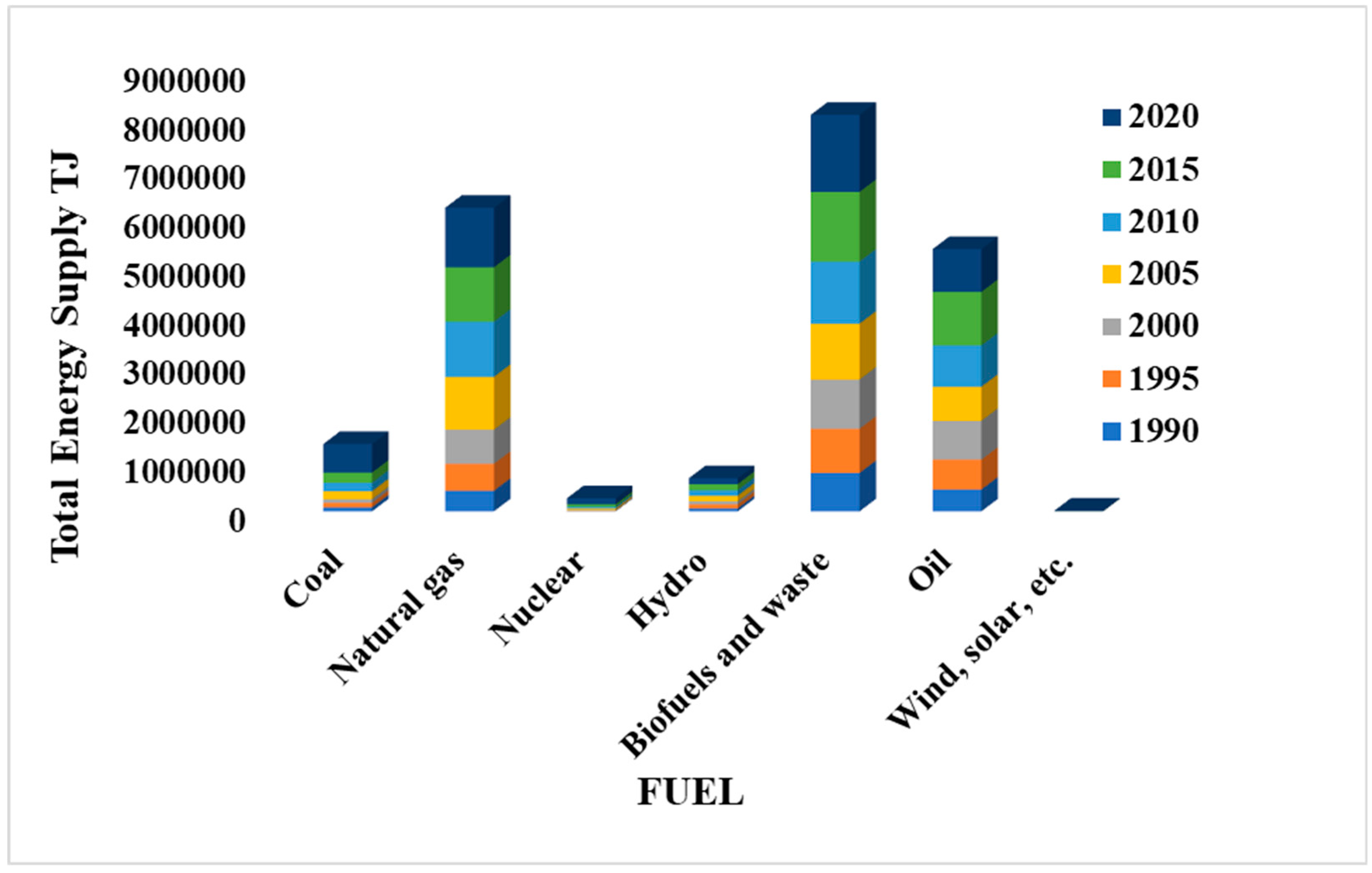
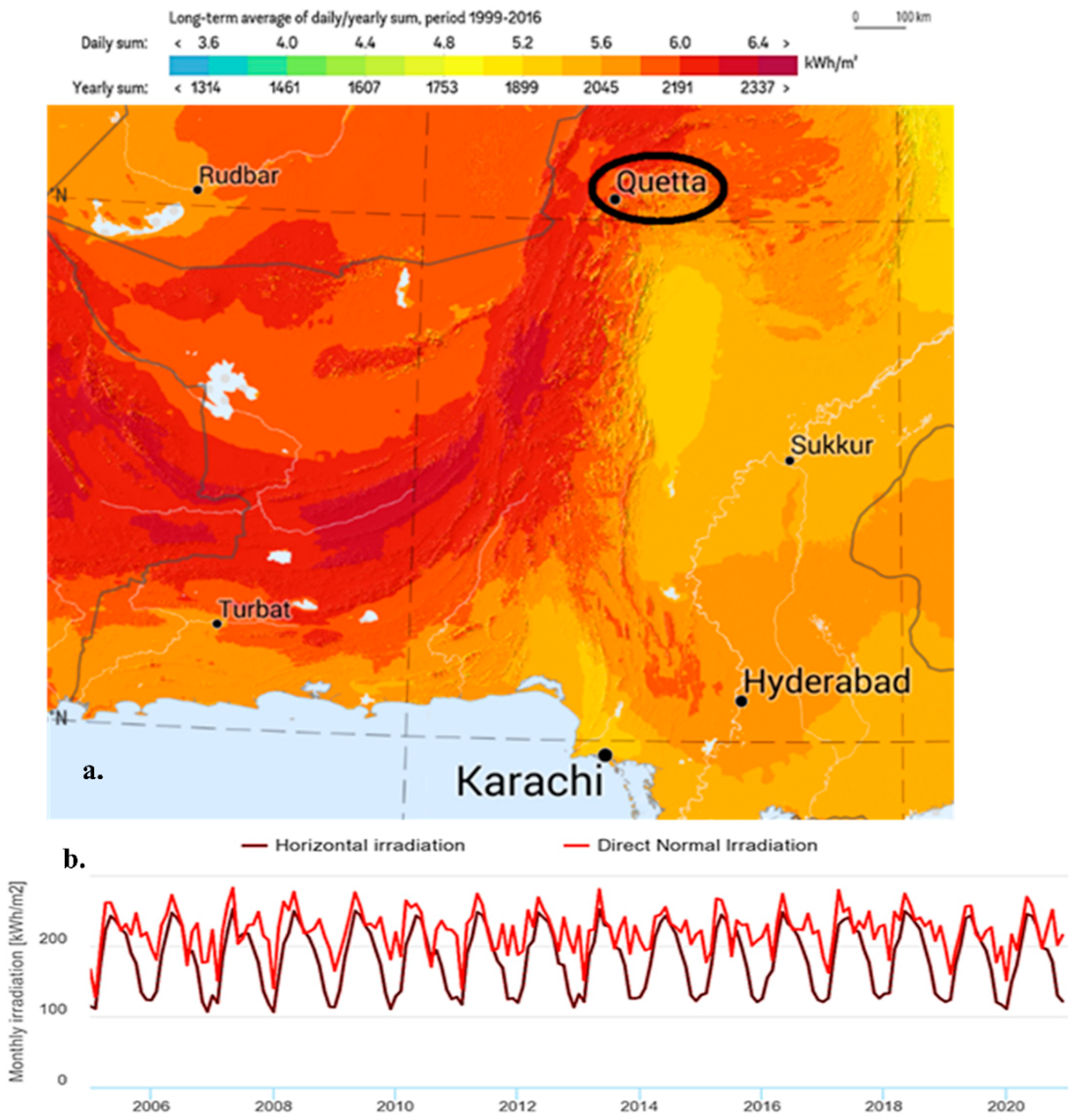
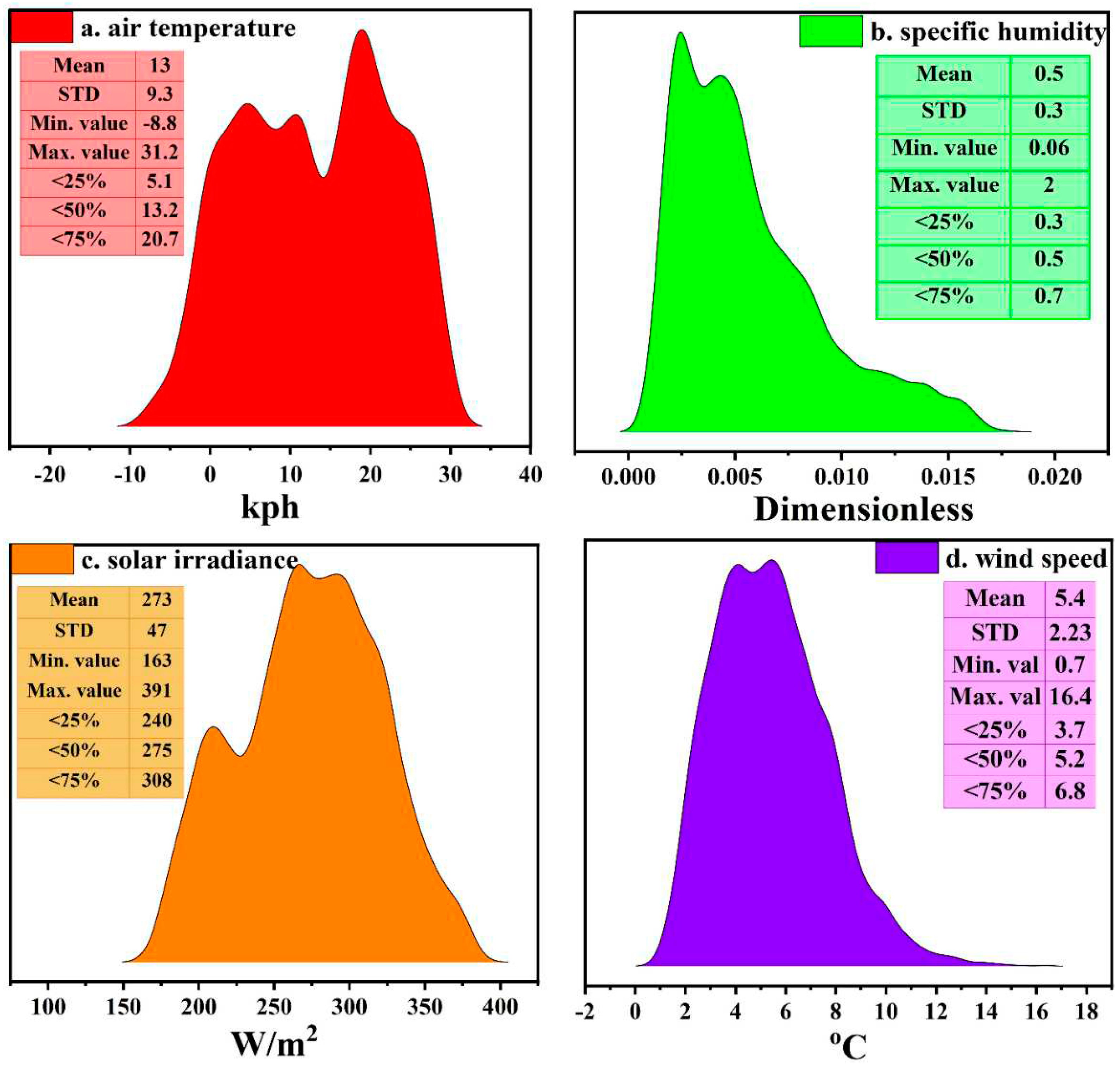
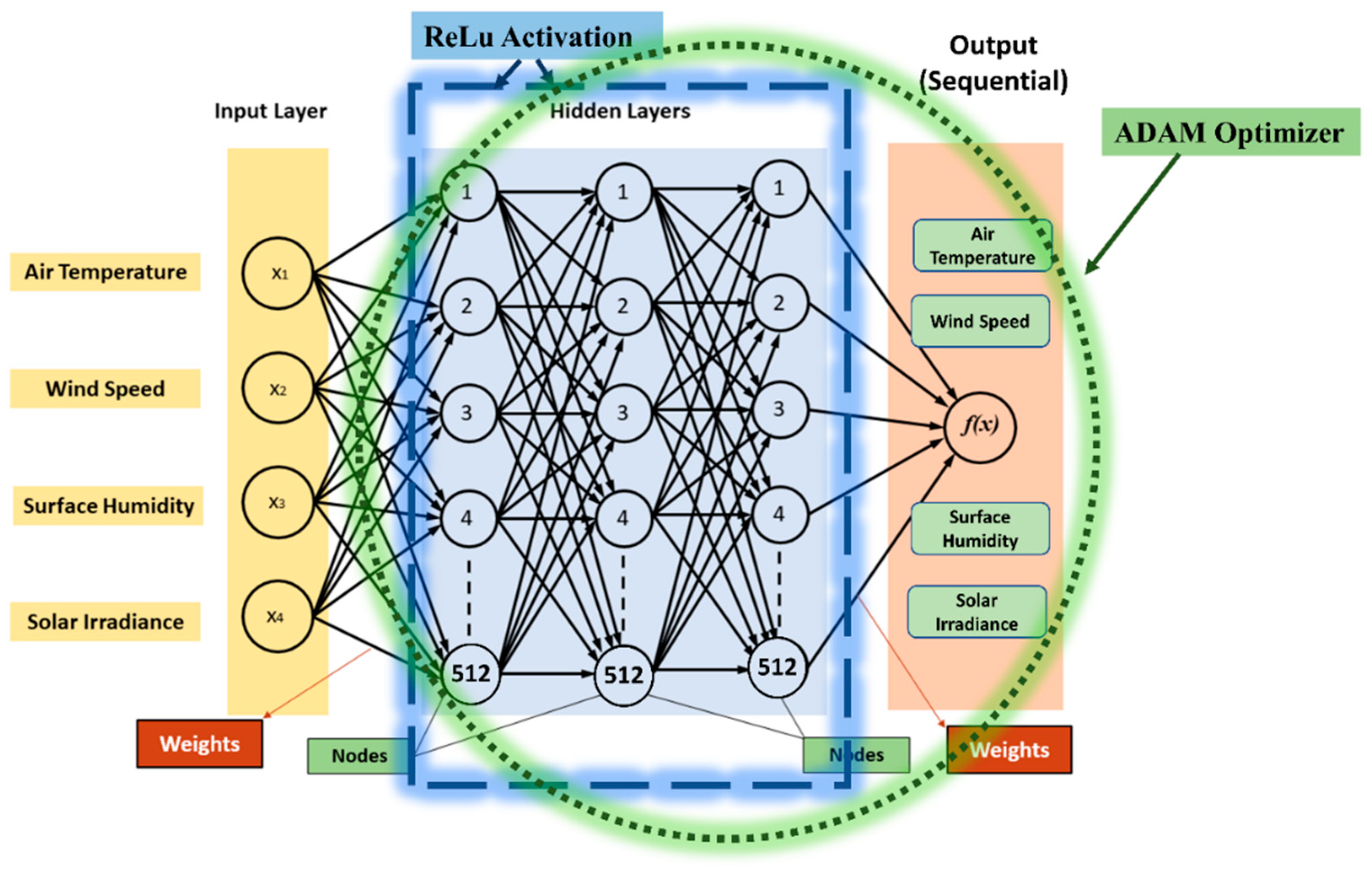
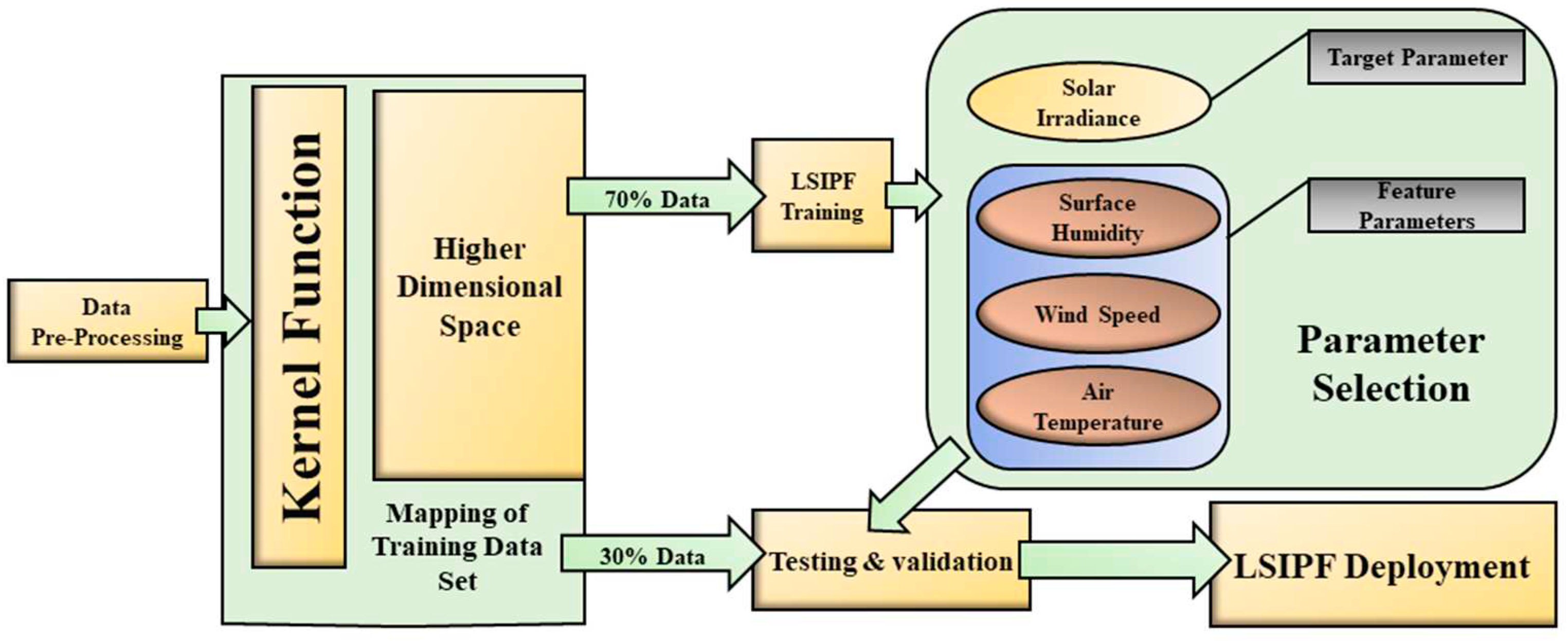
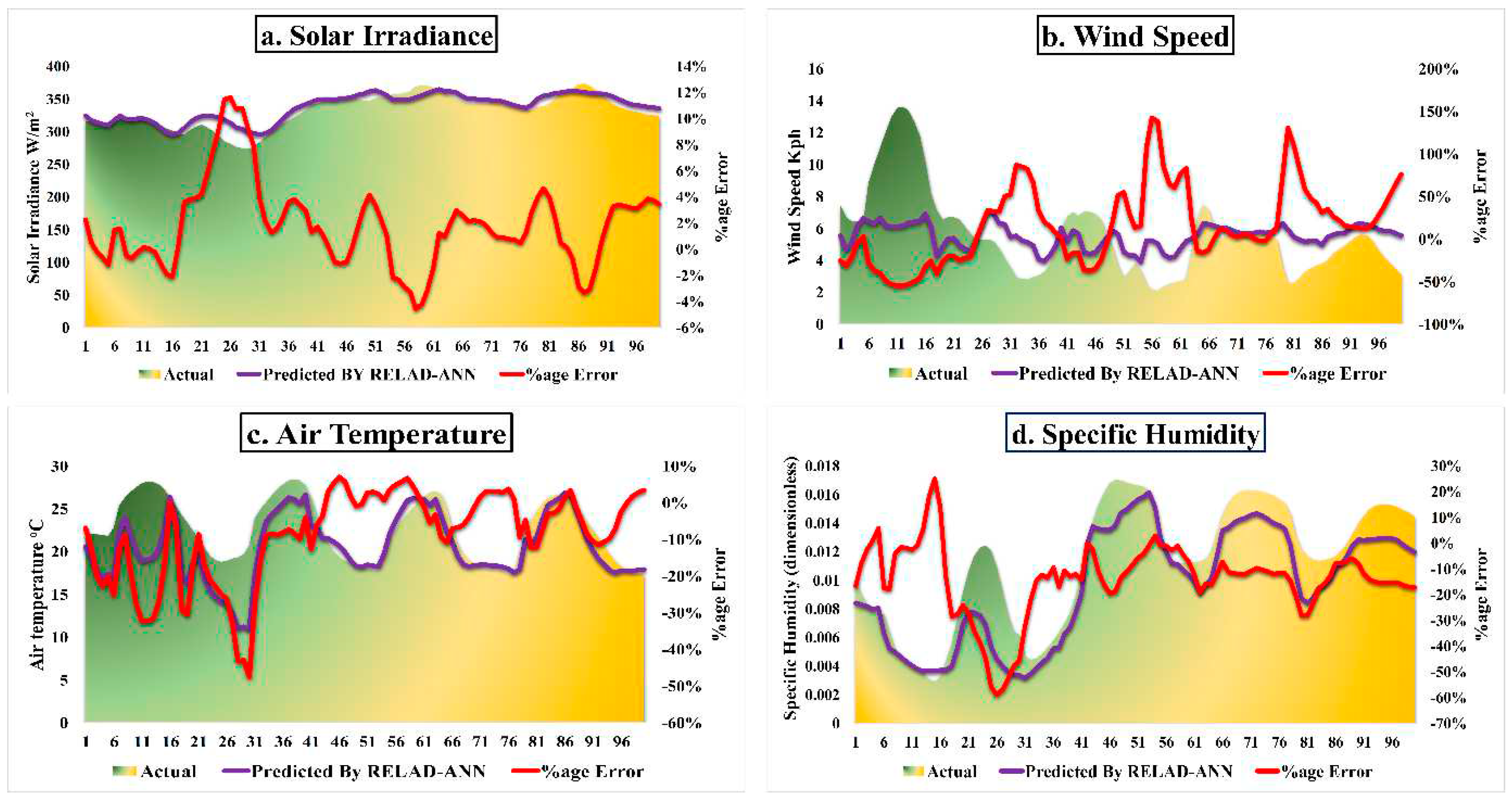
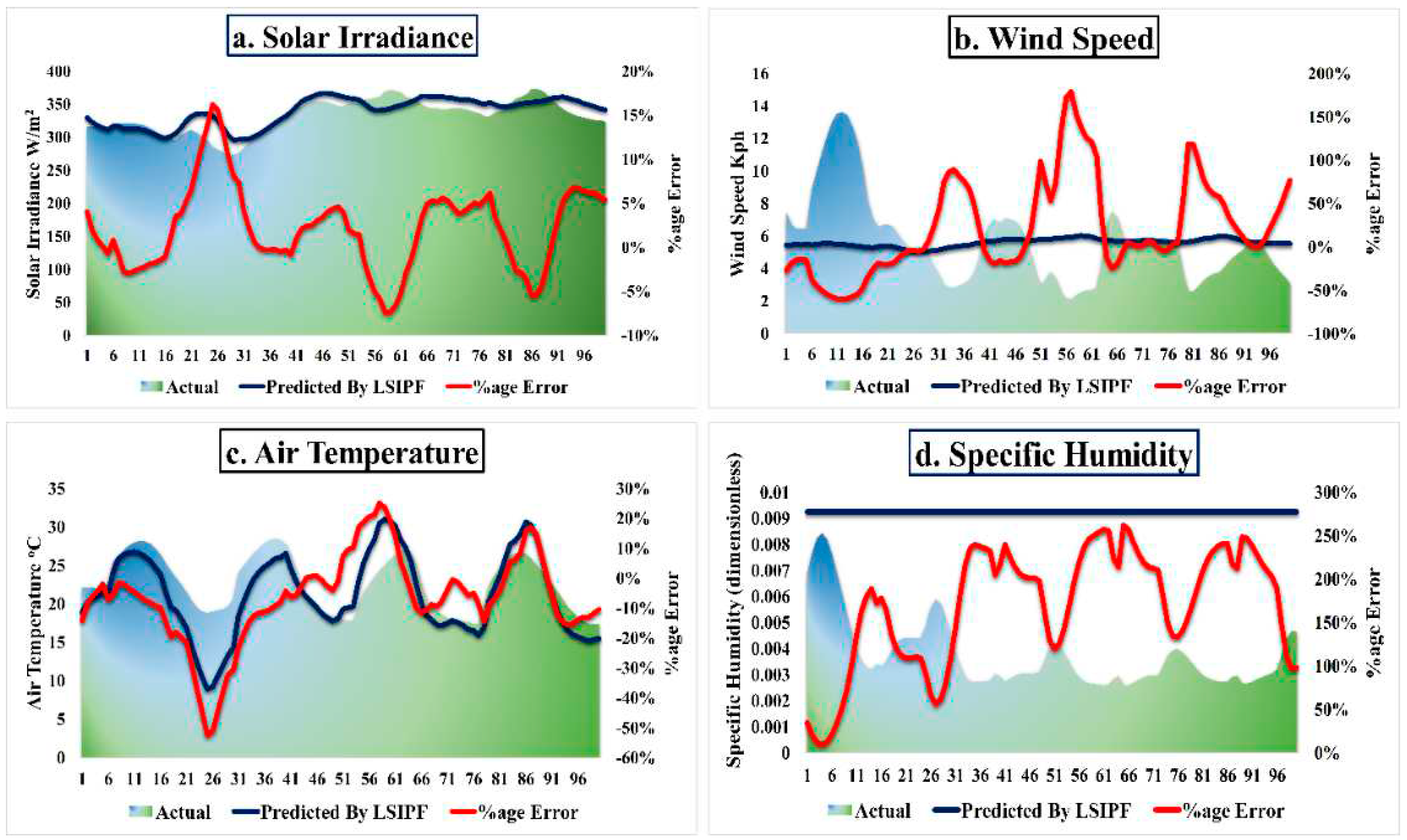
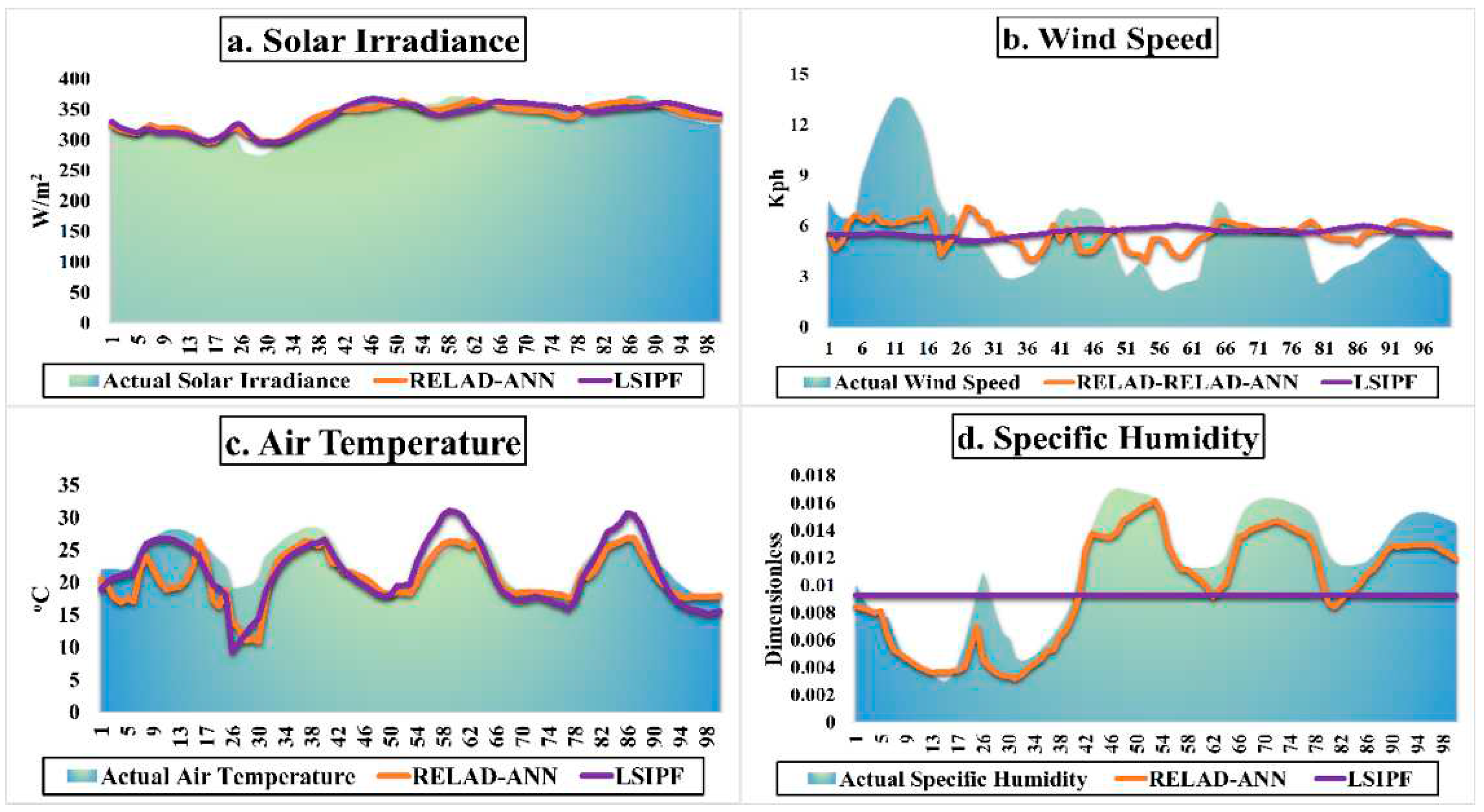
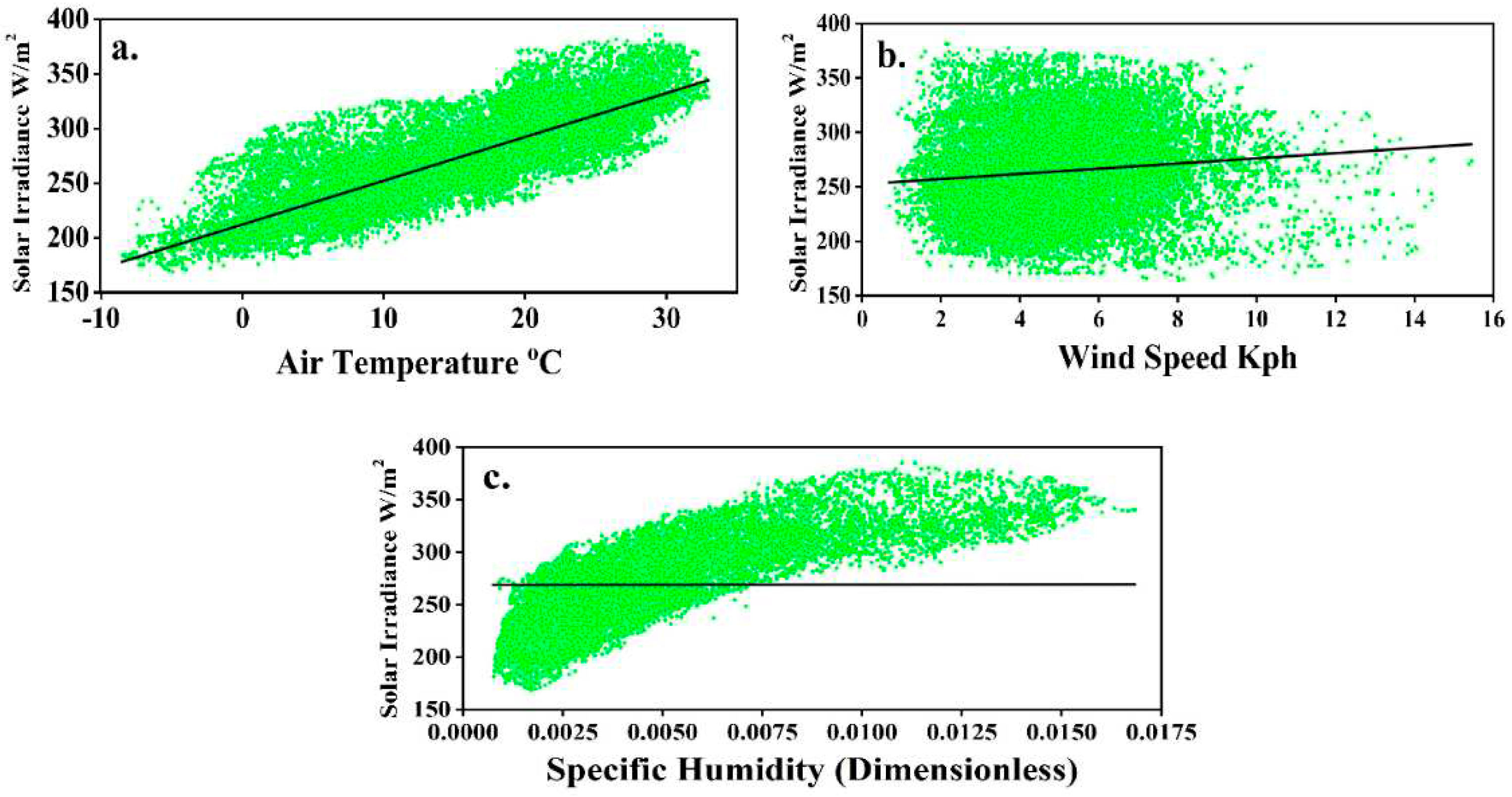
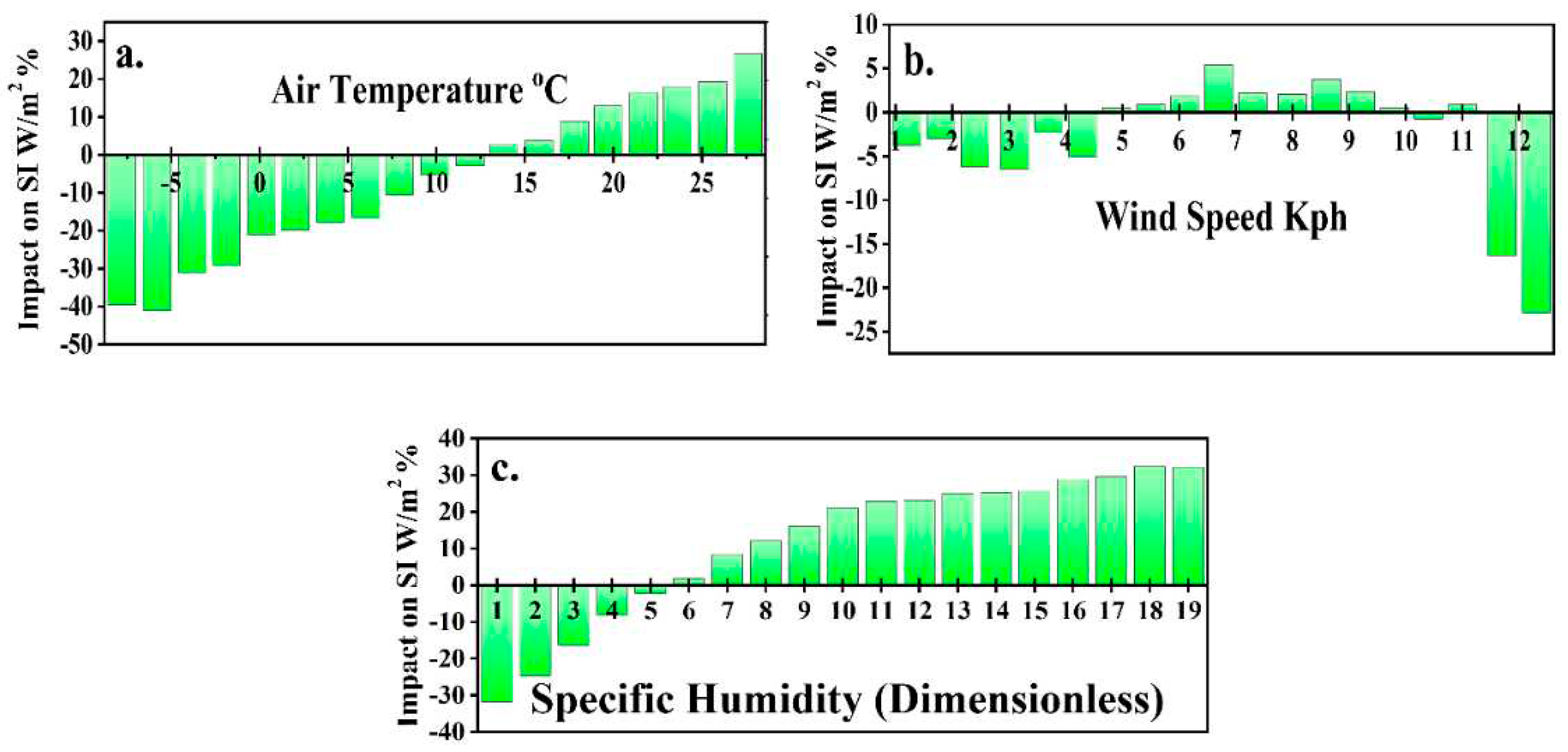
| Layer Type | Layer Name | No. of Nodes | Activation Function | Total Parameters | Optimizer |
| Input | Input Layer | 32 | ReLU | - | Adam |
| Dense | Hidden Layer 1 | 512 | ReLU | 2560 | Adam |
| Dense | Hidden Layer 2 | 512 | ReLU | 262656 | Adam |
| Dense | Hidden Layer 3 | 512 | ReLU | 262656 | Adam |
| Dense | Output Layer | 1 | ReLU | 513 | Adam |
| Parameters | Solar Irradiance | Wind Speed | Air Temperature | Specific Humidity | |
|---|---|---|---|---|---|
| Maximum actual value | 391.5 | 16.4 | 31.2 | 0.02 | |
| Minimum actual value | 150.0 | 0.9 | -9.8 | 0.0005 | |
| Maximum predicted value | RELAD-ANN | 373.6 | 8.3 | 27.6 | 0.02 |
| LSIPF | 367.0 | 6.1 | 31.7 | 0.01 | |
| Minimum predicted value | RELAD-ANN | 175.0 | 2.7 | -9.3 | -0.003 |
| LSIPF | 172.0 | 4.3 | -10.4 | 0.01 | |
| Maximum variance with actual | RELAD-ANN | 55.4 | 11.6 | 16.2 | 0.007 |
| LSIPF | 55.7 | 10.3 | 16.6 | 0.008 | |
| Minimum variance with actual | RELAD-ANN | 0.0013 | 0.003 | 0.001 | 9.1E-08 |
| LSIPF | 0.0016 | 8.5E-05 | 0.001 | 5.0E-06 | |
| Average variance | RELAD-ANN | 8.2 | 1.8 | 2.7 | 0.0006 |
| LSIPF | 12.0 | 1.7 | 3.3 | 0.006 | |
| Parameters | Model | R2 | MBE | MABE | MAE | RMSE | MAPE |
|---|---|---|---|---|---|---|---|
| Solar Irradiance | LSIPF | 0.893 | -4.62 | 4.62 | 11.96 | 15.09 | 0.05 |
| RELAD-ANN | 0.933 | 0.41 | 0.41 | 8.13 | 11.30 | 0.03 | |
| Wind Speed | LSIPF | 0.0008 | 0.35 | 0.35 | 1.70 | 2.26 | 0.37 |
| RELAD-ANN | 0.012 | 0.43 | 0.43 | 1.91 | 2.5 | 0.42 | |
| Air Temperature | LSIPF | 0.757 | 0.99 | 0.99 | 3.31 | 4.2 | 0.8 |
| RELAD-ANN | 0.797 | 1.21 | 1.21 | 2.83 | 3.68 | 0.52 | |
| Surface Humidity | LSIPF | 2.12E-30 | -0.01 | 0.01 | 0.01 | 0.01 | 0.64 |
| RELAD-ANN | 0.894 | -0.007 | 0.007 | 0.0008 | 0.001 | 0.38 |
Disclaimer/Publisher’s Note: The statements, opinions and data contained in all publications are solely those of the individual author(s) and contributor(s) and not of MDPI and/or the editor(s). MDPI and/or the editor(s) disclaim responsibility for any injury to people or property resulting from any ideas, methods, instructions or products referred to in the content. |
© 2023 by the authors. Licensee MDPI, Basel, Switzerland. This article is an open access article distributed under the terms and conditions of the Creative Commons Attribution (CC BY) license (http://creativecommons.org/licenses/by/4.0/).





